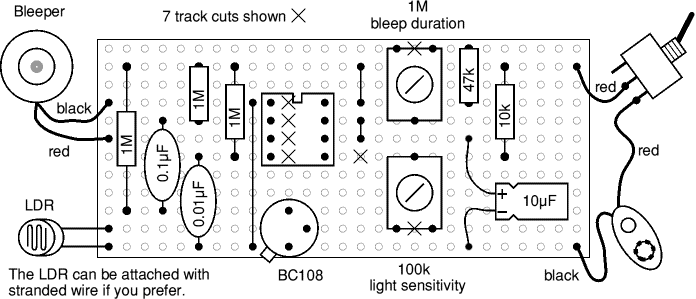Light-sensitive Alarm Project
The circuit detects a sudden shadow falling on the light-sensor and sounds the
bleeper when this happens. The circuit will not respond to gradual changes in brightness
to avoid false alarms. The bleeper sounds for only a short time to prevent the battery
running flat. Normal lighting can be used, but the circuit will work best if a beam of
light is arranged to fall on the light-sensor. Breaking this beam will then cause the
bleeper to sound.
The light sensor is an LDR (light-dependant resistor), this has a low resistance in bright
light and a high resistance in dim light.
- The light-sensitivity of the circuit can be adjusted by varying the 100k preset.
- The length of bleep can be varied from 0.5 to 10 seconds using the 1M preset.
Using the 7555 low-power timer ensures that the circuit draws very little current
(about 0.5mA) except for the short times when the bleeper is sounding (this uses about 7mA).
If the circuit is switched on continuously an alkaline PP3 9V battery should last about
a month, but for longer life (about 6 months) you can use a pack of 6 AA alkaline batteries.
This project uses an edge-triggered 555 monostable circuit.
Parts Required
- resistors: 10k, 47k, 1M ×3
- presets: 100k, 1M
- capacitors: 0.01µF, 0.1µF, 10µF 25V radial
- transistor: BC108 (or equivalent)
- 7555 low-power timer IC
- 8-pin DIL socket for IC
- LDR (light-dependant resistor) type ORP12
- bleeper 9-12V
- on/off switch
- battery clip for 9V PP3
- stripboard 12 rows × 25 holes
Stripboard Layout

Circuit diagram

© Designed & Published in :
Midori`s Talar


